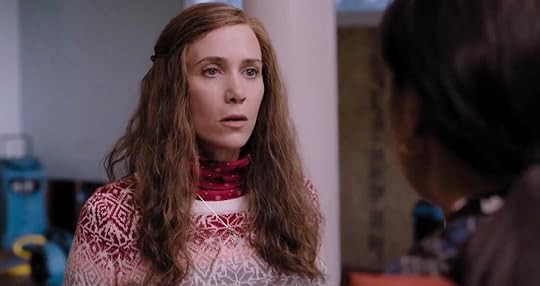“Where’d You Go, Bernadette” by Maria Semple is a novel that masterfully blends humor with poignant observations about creativity, social anxiety, and family dynamics. Narrated through an epistolary format, primarily via emails, letters, and documents compiled by Bernadette Fox’s daughter, Bee, the story unfolds the mystery of Bernadette’s sudden disappearance. This unique structure offers a compelling and often hilarious glimpse into the life of a once-celebrated architect grappling with personal and societal pressures in Seattle.
The narrative kicks off with Bee’s successful academic performance, entitling her to a promised reward: any trip she desires. Her choice? Antarctica, a destination that throws her agoraphobic mother, Bernadette, into a spiral of anxiety. Bernadette, a former architectural genius, now finds herself stifled and deeply unhappy in Seattle, a city she openly despises and refers to its inhabitants as “gnats.” Her disdain for Seattle and its social scene is a constant source of comedic relief, delivered through her witty and often scathing emails to Manjula, her virtual assistant based in India. This online concierge handles Bernadette’s day-to-day tasks, becoming the recipient of her hilarious diatribes against suburban life and the perceived absurdities of the “Emerald City.”
 Cate Blanchett as Bernadette Fox in Where'd You Go, Bernadette movie adaptation
Cate Blanchett as Bernadette Fox in Where'd You Go, Bernadette movie adaptation
Bernadette’s character is central to the novel’s charm. She’s brilliantly portrayed as anti-social and agoraphobic, preferring the confines of her dilapidated former school for girls, Strait Gate, to engaging with the outside world. This house, a metaphor for Bernadette’s own state of disrepair, is a character in itself. Described as a nine-thousand-square-foot fixer-upper with a roof reminiscent of Notre Dame after a fire, it reflects her neglect and creative stagnation. The blackberry vines encroaching upon the structure and the piles of unwashed dishes symbolize her retreat from domestic norms and societal expectations.
Her primary connection to the world is through her daughter, Bee Branch. Bee is not just Bernadette’s daughter but also her confidante and best friend. When Bee earns straight A’s and requests the Antarctica trip, it sets in motion a series of events that force Bernadette to confront her anxieties and her past. The promised trip becomes a catalyst for Bernadette’s journey, both physically and emotionally.
 Emma Nelson as Bee Branch in Where'd You Go, Bernadette film
Emma Nelson as Bee Branch in Where'd You Go, Bernadette film
Adding layers to the narrative is Bernadette’s strained marriage with Elgin Branch, a successful Microsoft employee consumed by his work. Elgin, or Elgie, is loving but often absent, leaving Bernadette feeling isolated and unsupported. His new assistant, Soo-Lin, introduces an element of workplace drama and subtle romantic tension, further complicating Bernadette’s already complex life. The external pressures mount with Bernadette’s neighbor, Audrey, a quintessential Seattle “gnat,” who embodies everything Bernadette loathes about her surroundings. Their conflict over encroaching blackberry vines escalates into a neighborhood dispute, highlighting Bernadette’s inability to navigate even the simplest social interactions.
As the title suggests, Bernadette eventually disappears. Her departure is not entirely unexpected, given her mounting frustrations and desire to escape. The novel then shifts to Bee’s perspective as she pieces together the events leading up to her mother’s disappearance, creating a compelling mystery that keeps the reader engaged. The epistolary format works brilliantly here, revealing information gradually through different characters’ viewpoints and communications, building suspense and deepening our understanding of Bernadette’s motivations.
 Kristin Wiig portrays Audrey in Where'd You Go, Bernadette movie
Kristin Wiig portrays Audrey in Where'd You Go, Bernadette movie
Semple’s writing is sharp, witty, and infused with dark humor. Bernadette’s internal monologues and email exchanges are laugh-out-loud funny, even as they reveal her underlying pain and creative frustration. The novel explores the consequences of stifled creativity and the importance of pursuing one’s passions. Bernadette’s architectural talent, once world-renowned, has been dormant for years, contributing to her malaise. The book subtly argues that creative expression is not just a hobby but a vital need, especially for individuals like Bernadette.
While the humor is a significant draw, “Where’d You Go, Bernadette” also delves into deeper themes of mental health, motherhood, and self-discovery. Bernadette’s struggles with anxiety and social phobia are portrayed with sensitivity and understanding, making her a relatable and sympathetic character despite her eccentricities. Her relationship with Bee is the emotional core of the novel, showcasing a deep bond built on mutual respect and affection.
 Emma Nelson as Bee Branch in Where'd You Go, Bernadette film
Emma Nelson as Bee Branch in Where'd You Go, Bernadette film
The setting of Seattle plays a crucial role, acting as both a backdrop and a foil to Bernadette’s personality. Semple, who herself moved to Seattle, injects her own experiences and observations into Bernadette’s hilarious rants about the city and its culture. However, as the novel progresses, a subtle shift occurs, mirroring Semple’s own evolving perspective on Seattle. This nuanced portrayal of place adds depth and authenticity to the narrative.
“Where’d You Go, Bernadette” is a thoroughly enjoyable and engaging read. Its witty prose, quirky characters, and compelling plot make it a standout novel. While some plot devices might stretch believability, the charm of Bernadette and her relationship with Bee, coupled with the novel’s humor, more than compensate for any minor shortcomings. It’s a story that will make you laugh, ponder, and ultimately appreciate the importance of embracing one’s true self and creative spirit. If you’re looking for a book that is both funny and insightful, “Where’d You Go, Bernadette” is highly recommended.
